Caitlin Clark is truly one of a kind—women’s basketball has never witnessed anything like her before.
Caitlin Clark is one of one. No phrase better captures the phenomenon that has swept across women’s basketball like a tidal wave. She’s not just a star, not just a scorer, and not just a symbol—she’s a revolution in motion. The game has seen legends before, icons who changed the trajectory of the sport, from Lisa Leslie to Diana Taurasi, from Maya Moore to Candace Parker. But Clark has brought something entirely different, something not easily measured in trophies or statistics, though she certainly possesses plenty of both. Her impact is cultural, generational, and transformative. In every sense of the word, women’s basketball has never seen anything like Caitlin Clark.
From the moment she stepped onto a college court at Iowa, it was clear that Clark was wired differently. She didn’t ease her way into national prominence—she stormed into it with a barrage of logo threes, no-look assists, and a fearless demeanor that dared defenders to keep up. She wasn’t just playing basketball; she was redefining how the game could be played. Audiences, initially tuning in out of curiosity, kept coming back in larger and larger numbers because Clark delivered something electric every night. It wasn’t a gimmick. It was greatness, unfolding in real time.
Statistically, Clark has set a new bar. She shattered the NCAA all-time scoring record, men’s or women’s, becoming the highest scorer in college basketball history. But her game was never about padding stats—it was about domination and elevation. She led the Iowa Hawkeyes to back-to-back national championship games, taking a program that had never seen that kind of spotlight and turning it into the epicenter of college basketball. That’s not just production. That’s legacy.
But numbers alone don’t tell the full story. What Caitlin Clark did was make people care. She brought in fans who never previously watched women’s basketball. She packed arenas not just in Iowa City, but across the country. Every road game became a Caitlin Clark show. Ticket prices soared, broadcasts broke records, and people started asking: where has this been all along? The answer, of course, is that the talent was always there, but it took someone like Clark—a transcendent figure—to make the world pay attention.
Part of Clark’s appeal lies in her unfiltered passion. She plays with a chip on her shoulder, never backing down from opponents, trash talk, or the magnitude of the moment. That fire isn’t arrogance—it’s authenticity. She plays for something bigger than herself. Whether she’s pointing to the scoreboard or silencing a hostile crowd, it’s clear she’s writing her own script. And she’s not afraid to be the villain in one arena and the hero in another. In fact, she seems to relish it. That duality—of being loved and hated, cheered and booed—only elevates her legend.
What also sets Clark apart is her skill set. She combines elite scoring with elite playmaking, a rarity even among the greatest players. She sees the floor like a seasoned veteran, whipping passes through narrow lanes, running the offense with precision, and creating for her teammates in ways that make them better. Yet, when it’s time to take over, she does it with flair. The deep three-pointers are not just flashy—they’re momentum-shifting, crowd-silencing daggers. She has Steph Curry’s range, Sue Bird’s vision, and Diana Taurasi’s swagger. But again, she’s not the next anyone. She’s the first Caitlin Clark.
Beyond the court, Clark’s influence is perhaps even more staggering. She’s become a marketing juggernaut, inking major NIL deals during her college years and now transitioning to the WNBA with massive expectations. Merchandise bearing her name and likeness flies off the shelves. Young girls wear her jersey and copy her moves in driveways and school gyms. She’s made it cool to be a women’s basketball fan. That kind of crossover appeal has rarely, if ever, been seen in the women’s game before.
And she hasn’t done it by being anything other than herself. In interviews, she’s candid and composed. In public appearances, she carries herself with poise and purpose. She’s been asked to shoulder enormous weight—the face of a sport, the hope of a league, the inspiration for a generation—and yet she hasn’t flinched. If anything, she’s leaned into the challenge. That, too, is part of what makes her so unique. She doesn’t just shine in the spotlight—she thrives in it.
Her move to the WNBA was among the most anticipated transitions in league history. When she was drafted No. 1 overall by the Indiana Fever, it was more than a moment—it was a cultural event. The Fever instantly became must-watch television. Road games sold out. Jersey sales broke records. Clark didn’t just join the league; she lifted it. And though the adjustment to the professional level comes with its bumps, Clark’s presence alone has already shifted the paradigm. The WNBA, long battling for media coverage and respect, now finds itself at the center of the national sports conversation, in no small part because of her.
Yet through it all, Clark remains grounded. She credits her teammates, honors her coaches, and never loses sight of where she came from. Her humility is as genuine as her competitive fire. She talks often about playing for her state, for her family, and for the little girls who now believe they too can play on the biggest stages. In a world that often demands perfection from public figures, Clark offers something more meaningful: sincerity. She’s not afraid to celebrate, to cry, to express frustration. She’s real. And that, perhaps more than anything else, is why people connect with her.
It’s also why her story is far from over. The WNBA is just the next chapter in what promises to be a long and historic career. She will face tougher defenses, more physical play, and the scrutiny that comes with being the sport’s marquee name. But if her college career taught us anything, it’s that Caitlin Clark doesn’t run from pressure—she embraces it. And if history is any guide, she will rise to meet it.
There’s also the matter of legacy, something that can only be fully understood over time. But already, Clark’s imprint is indelible. Youth participation in girls’ basketball is on the rise. Television networks are investing more in broadcasting women’s games. Brands are betting big on women athletes. And fans are showing up like never before. All of that didn’t happen by accident. Caitlin Clark didn’t just break records—she broke barriers.
In every sense, she represents what’s possible when talent meets opportunity. For years, women’s sports have battled for equal footing, for visibility, for investment. Clark didn’t fix all of that single-handedly, but she accelerated the movement in ways that can’t be overstated. She made it impossible to ignore the brilliance of the women’s game. And she did it by playing with joy, with grit, and with unapologetic excellence.
The comparisons will continue. Analysts will debate where she ranks among the all-time greats. But perhaps the most accurate thing anyone can say about Caitlin Clark is the simplest: she’s one of one. There has never been a player like her before. Not in how she plays, not in how she impacts the game, and not in how she inspires those who watch her.
She is not just a player. She is a movement. A spark that ignited a fire in women’s basketball that is still growing, still blazing, still burning down walls that once felt immovable. She didn’t just arrive—she erupted, and in doing so, changed everything. From college arenas to pro stadiums, from streaming devices to sneaker deals, her influence is woven into the fabric of the sport now.
And as her career continues to unfold, one truth will remain clear: Caitlin Clark isn’t following anyone else’s path. She’s paving her own. One record, one pass, one shot at a time. Women’s basketball has never seen this before. And it may never see it again. Because there is only one Caitlin Clark. There always has been. And there always will be.



